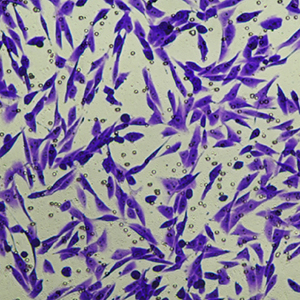 Smart Citations
Smart CitationsSee how this article has been cited at scite.ai
scite shows how a scientific paper has been cited by providing the context of the citation, a classification describing whether it supports, mentions, or contrasts the cited claim, and a label indicating in which section the citation was made.
Extracellular vesicles from bone mesenchymal stem cells transport microRNA-206 into osteosarcoma cells and target NRSN2 to block the ERK1/2-Bcl-xL signaling pathway
Osteosarcoma (OS) is a kind of malignant tumor originating from mesenchymal tissue Bone mesenchymal stem cells-derived extracellular vesicles (BMSCs-EVs) can play important roles in OS. This study investigated the mechanism of BMSCs-EVs on OS. BMSC surface antigens and adipogenic and osteogenic differentiation were detected by flow cytometry, and oil red O and alizarin red staining. EVs were isolated from BMSCs by differential centrifugation and identified by transmission electron microscopy, nanoparticle tracking analysis, and Western blot (WB). miR-206 and neurensin-2 (NRSN2) levels in human osteoblast hFOB 1.19 or OS cells (143B, MG-63, Saos2, HOS) were detected by RT-qPCR. Human OS cells with lower miR-206 levels were selected and treated with BMSCs-EVs or pSUPER-NRSN2. The uptake of EVs by 143B cells, cell proliferation, apoptosis, invasion, and migration were detected by immunofluorescence, 5-ethynyl-2’-deoxyuridine (EdU) and colony formation assays, flow cytometry, scratch test, and transwell assays. The binding sites between miR-206 and NRSN2 were predicted by Starbase database and verified by dual-luciferase assay. The OS xenograft model was established and treated by BMSCs-EVs. Tumor growth rate and volume, cell proliferation, and p-ERK1/2, ERK1/2, and Bcl-xL levels were detected by vernier caliper, immunohistochemistry, and WB. BMSCs-EVs were successfully extracted. miR-206 was diminished and NRSN2 was promoted in OS cells. BMSCs-EVs inhibited proliferation, migration, and invasion, and promoted apoptosis of OS cells. BMSCs-EVs carried miR-206 into OS cells. Inhibition of miR-206 in EVs partially reversed the inhibitory effect of EVs on malignant behaviors of OS cells. miR-206 targeted NRSN2. Overexpression of NRSN2 reversed the inhibitory effect of EVs on OS cells. NRSN2 activated the ERK1/2-Bcl-xL pathway. BMSC-EVs inhibited OS growth in vivo. In summary, BMSC-EVs targeted NRSN2 and inhibited the ERK1/2-Bcl-xL pathway by carrying miR-206 into OS cells, thus inhibiting OS progression.
Edited by
All procedures were authorized by the Academic Ethics Committee of First People’s Hospital of Kashgar, Xinjiang, ChinaRights
This work was supported by Xinjiang Natural Science FoundationHow to Cite

This work is licensed under a Creative Commons Attribution-NonCommercial 4.0 International License.
PAGEPress has chosen to apply the Creative Commons Attribution NonCommercial 4.0 International License (CC BY-NC 4.0) to all manuscripts to be published.








